Marine Protected Area network: 2024 report to the Scottish Parliament
A report to the Scottish Parliament on progress being made in implementing Scotland's Marine Protected Area (MPA) network.
9. Managing MPAs:
what impacts have measures had?
The purpose of management measures is to support the conservation objectives of the protected habitats and species to be achieved. Collectively the management of MPAs will help safeguard marine biodiversity and build resilience to the impacts of climate change, supporting our seas to provide economic, social and wider benefits for people, the economy and society.
Where damage has taken place, recovery through natural processes can take a considerable length of time.
There are numerous challenges for assessing the effectiveness of management that include both environmental and biological factors. The sea is a dynamic environment which makes quantifying change or trends inherently difficult, requiring long-term data collection. In addition, many marine species and habitats are slow-growing and can be dependent on or influenced by factors outside the MPA network.
Nonetheless there is a growing body of evidence that demonstrates the effectiveness of protecting and managing MPAs. Four case studies are set out below, showcasing how management interventions are helping to achieve the conservation objectives of MPAs, whether it be some of our most sensitive habitats or endangered species.
Case Study One
Recovery of flame shell beds in the Loch Carron MPA following emergency management measures
Loch Carron MPA is home to multiple flame shell beds including the largest known flame shell bed in the world (Moore etal.,2018), encompassing around a quarter of a billion flame shells. Flame shell beds provide habitat complexity that supports a wide range of other plants and animals and provides a nursery ground for commercial species.

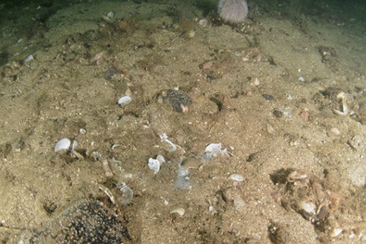
In 2017, the Scottish Government's Marine Directorate responded to local community concerns about damage to the flame shell bed habitat by legal fishing activity. An urgent MPA was put in place with a Marine Conservation Order to prohibit the use of towed, bottom-contacting fishing gear, i.e. trawling and dredging, to protect the flame shell beds from further damage. The MPA and fisheries measures were made permanent in 2019 following advice from NatureScot and public consultation.
NatureScot and Marine Directorate surveys of the dredge damage in 2017 showed bands of flattened and broken up flame shell turf, as well as the presence of dead and broken shell material. Significant numbers of flame shells persisted in impacted areas which allowed some re-establishment of bed material within three months of dredging. In 2019 dredge scars were still visible at two sites on the north Sgeir Bhuidhe bed with distinct parallel dredge tracks apparent at one site (Moore, 2020). Further dive surveys in 2021 revisited the same sites as in 2017, surveying both dredge tracks and control areas which had not been dredged. By 2021, four years after the first survey, the dredge tracks were no longer visible and the survey results overall showed that recovery is well advanced with no evidence of differences between the dredge tracks and the surrounding flame shell beds (Harries, 2023).
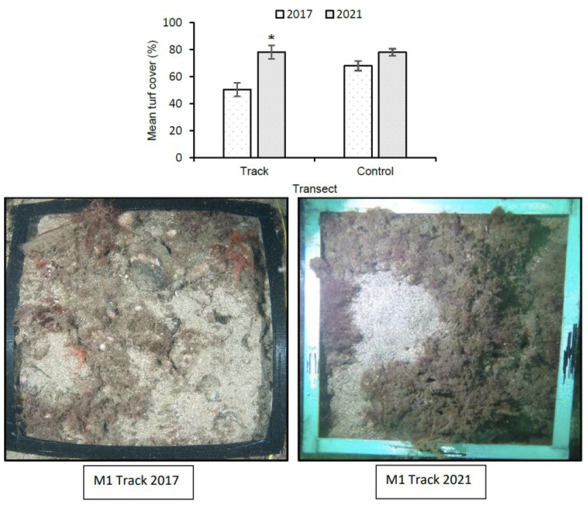
Further investigations in 2021 looked at the composition and structure of the associated communities in the control and dredged sites. Early results from this work also show that the flame shell communities have recovered well.
The management measures put in place after the damage occurred have ensured no further damage to the flame shell bed and allowed significant recovery. The recovery of the flame shell bed in the dredge tracks has been much faster than might have been expected given previous studies which estimated a relatively long recovery time (Trigg & Moore., 2009). However, it appears that the bed in Loch Carron had only experienced a single passage of a scallop dredge and therefore the damaged area was surrounded by extensive areas of intact flame shell beds. In addition, whilst nest material was considerably disrupted, it was not entirely removed from the dredge tracks, perhaps aiding recovery times. It is probable that recovery in a more extensive or intensely disturbed area would be considerably slower or may require active restoration.
The protection of this important and productive habitat benefits the high biodiversity supported by the flame shell beds including commercial fish and shellfish such as scallops, particularly
in juvenile stages. Protecting highly biodiverse, structurally complex habitats from human disturbance allows a place for nature to thrive which has predicted benefits within and outside the site, including allowing a refuge for species to better withstand the impacts of climate change.
Case Study Two
The Darwin Mounds SAC
The Darwin Mounds Special Area of Conservation (SAC) was the first deep-sea Marine Protected Area (MPA) established in UK waters, with depths ranging from 710 m to 1,129 m (Figure 15).
Located 160 km north-west of Cape Wrath, Scotland, this 1,377 km2 SAC was designated to protect cold-water corals from further damage by deep-water trawling (Wheeler et al. 2005; De Santo & Jones 2007; Chaniotis et al., 2018). Discovered in 1998, the cold-water corals grow on top of sandy mounds within the site, creating an important habitat for fish and invertebrate species
such as brittlestars, starfish and sponges (Bett, 2001). Cold-water corals are vulnerable to human activities, as their slow growing nature means recovery can take many years. Preventing further damage by protecting the area the corals live on is an important step towards helping the reefs recover (Beazley et al., 2021).
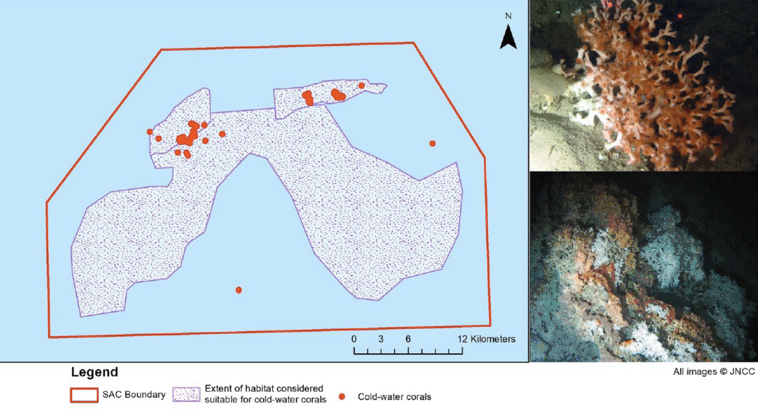
An 'emergency measure' for the management of fishing activity was first established in 2003, after considerable damage to the area caused by deep-water trawling was observed in 2000 (Bett, 2000; Wheeler etal., 2005). This measure, made permanent in 2004, banned bottom trawling in an area surrounding the mounds. This represented the first example of an offshore fisheries closure being introduced primarily for nature conservation purposes as opposed to the management of fish stocks (De Santo & Jones, 2007). In 2008, Darwin Mounds was submitted as a candidate SAC under the EU Habitats Directive (European Commission, 1992) for the protection of biogenic 'reef' habitat – the cold-water coral reefs – and the site was subsequently designated as a SAC in 2015. The Darwin Mounds SAC represented the first instance in the UK deep sea of two conservation actions being combined: an MPA designation and a fisheries closure.
In 2011, habitat mapping was carried out to assess the status of Darwin Mounds; known as a 'baseline survey' (Huvenne etal., 2011). Subsequent surveys have since been undertaken to assess how well the fisheries closure is working and if the site is recovering. Key findings show the fisheries closure has been successful in preventing further damage to the reefs, however, there has, as of yet, been no signs of reef recovery (Huvenne etal., 2016). Reasons for the absence of coral recovery are currently unclear, but may be linked to reproduction as the cold-water coral of the Darwin Mounds has previously been found to be non-reproductive (Waller & Tyler, 2005). Reef recovery may therefore depend on the entry of new coral larvae from areas outside Darwin Mounds SAC via ocean currents (Strong etal., 2023). Coral larvae entering from outwith the SAC have been identified as coming from cold-water coral reefs at Rosemary Bank Seamount, which is protected within the more recently designated West of Scotland MPA. Recent research confirmed that environmental conditions within Darwin Mounds remain favourable for the settlement and growth of new corals, highlighting the importance of the continued protection of both of these marine areas as part of a network within Scotland's deep sea (Strong etal., 2023).
Case Study Three
Monitoring South Arran MPA to understand management effectiveness
The South Arran MPA protects a range of interconnected and overlapping seabed habitats and species, including the largest known seagrass bed in the Clyde, maerl beds with the highest known percentages of live maerl in the Clyde and a population of ocean quahogs, the world's oldest living mollusc, which can live for up to approximately 400 years.
The habitats protected can have high biodiversity and provide nursery habitats for fish and shellfish as well as having an important function in stabilising the seabed. South Arran MPA is valued by the local community, and activities within the MPA provide opportunities for tourism businesses and increasingly act as a draw for visitors to Arran.
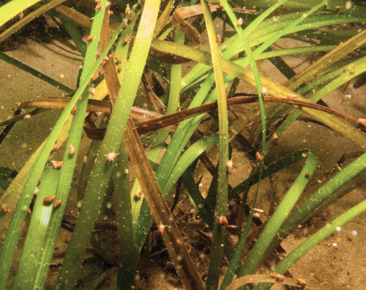
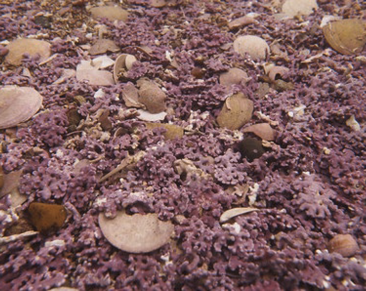
Part of the MPA, Lamlash Bay, is a no take zone (NTZ), which was established in 2008 following concerns over declines in fish and species numbers and deterioration of other species and marine habitats highlighted through a campaign led by the Community of Arran Seabed Trust (COAST). The South Arran MPA was designated in 2014, ensuring the protected features are given consideration via the consents and licensing process. A Marine Conservation Order prohibits the removal of all fish and shellfish in the NTZ and fisheries management was put in place for the wider site in 2016 including prohibition of dredging across the whole site, a zoned approach to trawling and four smaller zones where static fishing gear is prohibited.
There has been various research within the NTZ to look at the benefits of the site since 2010. Much of the research has been initiated by COAST in collaboration with universities, particularly the University of York. Results from 2022 surveys have shown positive effects of the NTZ for the abundance of a range of species when compared to dredged sites (McMahon and Stewart, 2024). For the commercially important species king scallop, the density, reproductive biomass and exploitable biomass was significantly greater within the NTZ and within the wider MPA where trawling/demersal gear is prohibited compared to dredged areas (in some areas, an 8.5-fold increase was seen; McMahon and Stewart, 2024). Recent research also shows that more diverse habitats are important for commercial fish species (Elliot et al, 2017a, Elliot et al, 2017b). For other species e.g. lobsters (Dyman, 2022; Cunningham et al 2024) and queen scallops (McMahon and Stewart 2024), the picture is more varied, where there are challenges in discerning changes from natural variability.
Monitoring at the site has been designed to see how the burrowed mud, seagrass and maerl beds change over time and how health and condition compare between areas with differing fisheries management. To date this has included photos, observations by divers, sediment cores and the collection of maerl samples for genetic analysis. The extent of some seagrass beds has been mapped using drones. It may take many years to quantify the changes in marine habitats, particularly the slow-growing maerl.
The prohibition of fishing in the NTZ since 2008 and spatial fisheries measures introduced for the MPA in 2016 have had a positive influence on seabed habitats and marine life within the South Arran MPA. These measures together with consideration of impacts from licensable activities associated with the site's status as an MPA contribute to protection of the designated features of the MPA by removing, reducing or minimising impacts from certain activities. This will have associated wider system benefits for ecosystem resilience, climate resilience and biodiversity to support the continued provision of benefits to people.
Case Study Four
Flapper skate in the Loch Sunart to the Sound of Jura Marine Protected Area
The flapper skate is the largest of all European skates and rays and as such is an ecologically important predator and a popular target of recreational angling. As explained in Section 6 it has experienced a significant decline which has led to the establishment of the Loch Sunart to the Sound of Jura Marine Protected Area in 2014 (Figure 18). Protection of a resident population of flapper skate was the main conservation objective of the MPA designation and for this purpose measures, such as fisheries closures and fishing gear restrictions, were introduced in 2016 (Loch Sunart to the Sound of Jura Marine Conservation Order 2016). A monitoring programme, including participatory citizen science involving anglers, has revealed the positive impacts of the fisheries measures on the resident population of flapper skate within the MPA. These results are published in the peer-reviewed journal "Aquatic Conservation" (Régnier et al. 2024).
Monitoring the effectiveness of the MPA requires an assessment of the state of the resident flapper skate population within the MPA following the introduction of fisheries measures. Key metrics such as resident population size, mortality rate, rates of movements within and outside the MPA are necessary to assess population recovery and the potential for spillover effects to benefit the wider area. Capture-Mark-Recapture programmes, involving the recapture of fish marked (using artificial or natural tags) at previous sampling occasions, allow the estimation of such metrics. The Capture-Mark-Recapture programme used relies on both a conventional tagging programme and participatory science, which relied on pictures submitted by recreational anglers and compiled in a photo-identification catalogue.
Following the introduction of fishing restrictions, a substantial increase in resident skate abundance was observed within the MPA. As the scale of this increase was not mirrored in the wider west of Scotland area, it appears to show that, following the introduction of measures to manage fishing activity, there was a recovery of the skate population living within the MPA. The recovery was associated with an increase in survival rate within the MPA. The limited movement of skate across the boundaries of the MPA, indicated a low level of spill over between the MPA and the wider area, suggesting a structure composed of multiple local, discrete populations.
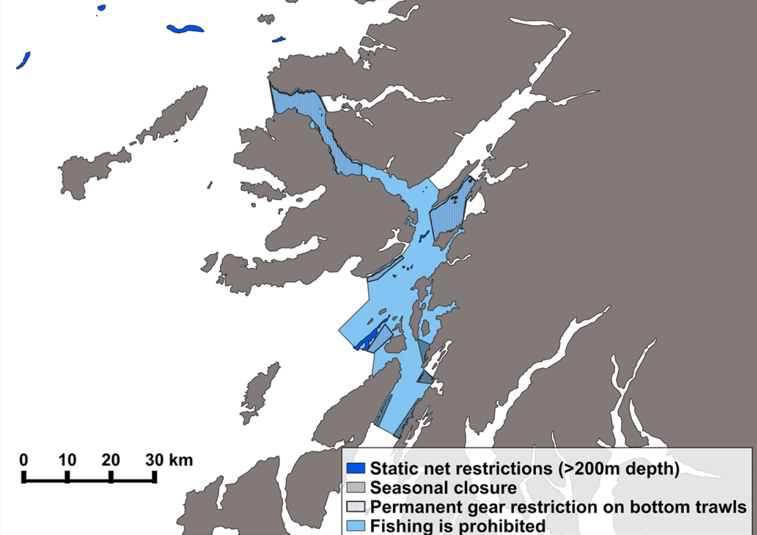
This study demonstrates that spatial fishery restrictions have the potential to markedly benefit populations of species, like flapper skate, which have a high site-fidelity. The recovery of the flapper skate may be accompanied by recovery of other demersal species and could have wider ecosystem impacts. Due to the high site-fidelity and limited movement observed in flapper skate, benefit may only be seen locally.
Contact
Email: marine_biodiversity@gov.scot
There is a problem
Thanks for your feedback